

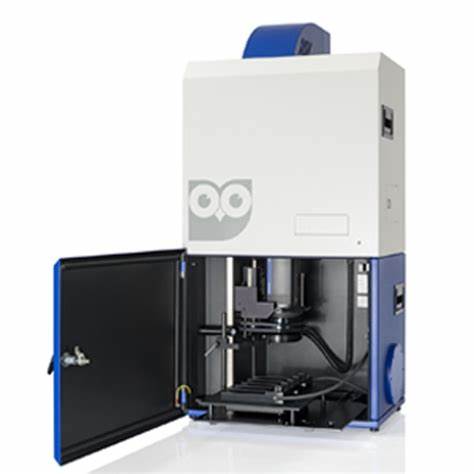

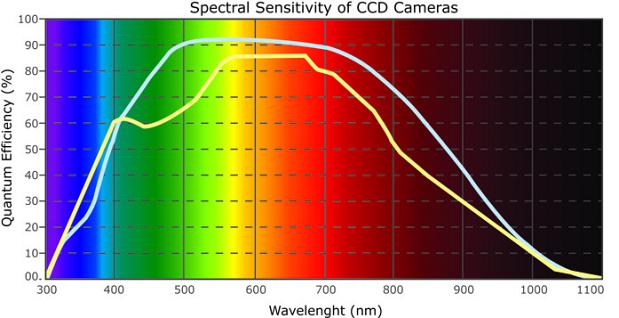
The NightOWL II uses an ultrasensitive back-illuminated (backlit) CCD camera with high quantum efficiency over the entire visible to near-infrared spectrum. Efficient cooling of the array (absolute -80 to -90°C depending on the room temperature) ensures very low noise, so that long exposure times can be used to integrate the signal over time and detect even weak light signals. The sensor dimensions are 13.3 x 13.3 mm, and captured images have 1024 x 1024 pixels, 13 µm in width which provides high imaging resolution.
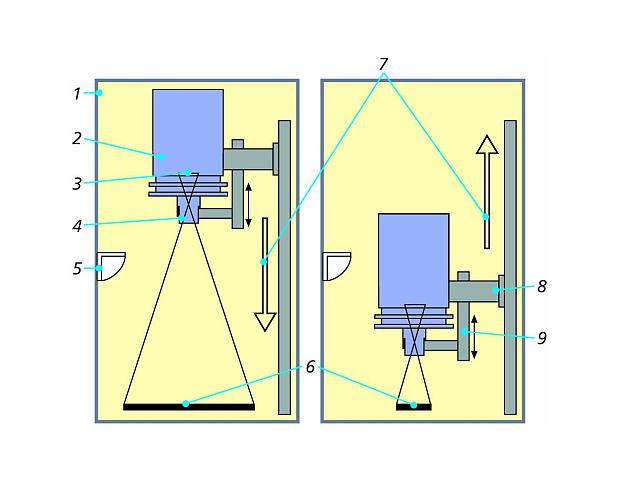
The NightOWL cabinet is extremely light-tight, preventing any interferences from ambient light. The NightOWL is the first imager with a motor-driven camera inside the cabinet. Optimum resolution and focus of the sample are achieved by automatic positioning of the camera according to the actual sample size. The camera can be moved from a height of 50 mm to 725 mm allowing focussing on every sample size up to 250 mm. For close-ups a macro table can be used. The camera is set up with flat field and height correction. This calibration eliminates non-uniformities caused by variations in the optical path due to height, illumination or lens effects.
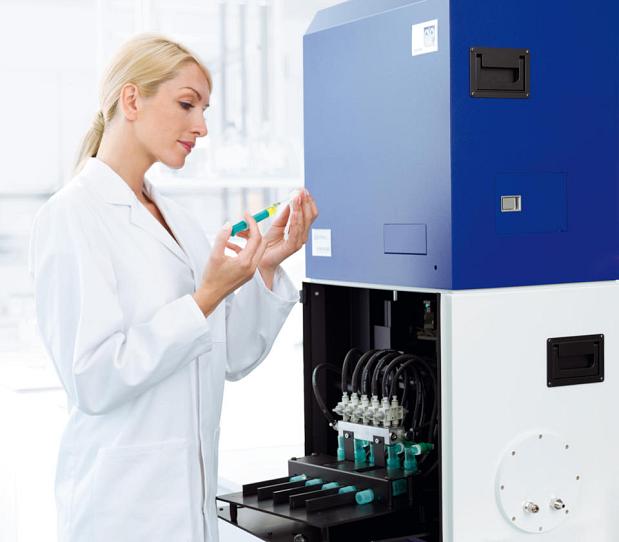
The conditions required to image living organisms can be very different depending on the application. To cover a broad range of applications, Berthold Technologies provides a very flexible system and a wide variety of accessories, including:
These devices may even be switched on and off through the software and the built-in sockets. This option enables the researcher to add more features into the cabinet.
The flange option provides light-tight access to the inner part for tubing, cables or even fibre optics, e. g. for special illumination of plants. The flange can be customized for special purposes.
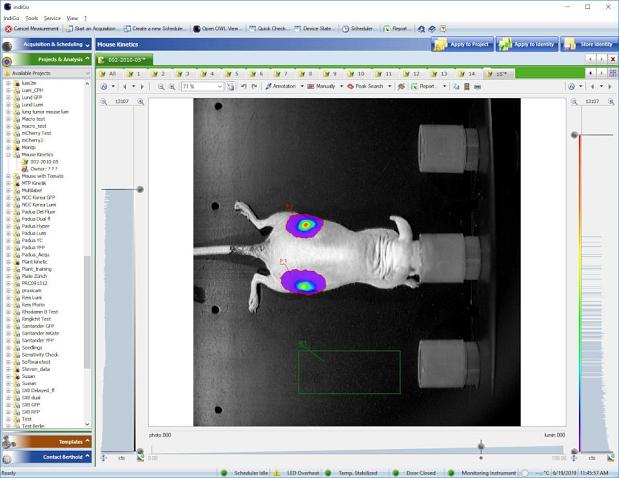
The user-friendly IndiGO™ software controls the instrument and makes image processing easy. IndiGO™ provides the following innovative features:
| Camera |
|
|
|---|---|---|
|
Resolution (sample size-dependent) * with macro table |
Sample size 20 cm 10 cm 5 cm 2 cm* 1 cm* |
Resolution 200 µm 100 µm 50 µm 20 µm 10 µm |
| Exposure times |
From 30 ms to hours |
|
| Pixel binning |
Variable to increase sensitivity |
|
| Filters |
4 excitation filters per slide 4 emission filters per wheel 340 nm up to 1100 nm Additional filter slides/wheels available |
|
| Light source | 75 W tungsten lamp | |
| Working distance | Automated positioning of the camera allows working distances between 50 mm and 725 mm. For working distances below 50 mm the macro table must be used. | |
| Interfaces |
Available to connect transiluminators, heaters, coolers, light sources… |
|
There are plenty of articles in the scientific literature using the NightOWL II in vivo imaging system. Here you have a selection of recent papers.
| Year | Authors | Journal | Title | Reporter |
|---|---|---|---|---|
| 2022 |
Xilin Wu, Yaxing Wang, Lin Cheng, Fengfeng Ni, Linjing Zhu, Sen Ma, Bilian Huang, Mengmeng Ji, Huimin Hu, Yuncheng Li, Shijie Xu, Haixia Shi, Doudou Zhang, Linshuo Liu, Waqas Nawaz, Qinxue Hu, Sheng Ye, Yalan Liu, and Zhiwei Wu |
Frontiers in Immunology |
YF®750 SE label (far-red) |
|
| 2022 |
Yujiro Kawai, Shugo Tohyama, Kenichi Arai, Tadashi Tamura, Yusuke Soma, Keiichi Fukuda, Hideyuki Shimizu, Koichi Nakayama, and Eiji Kobayashi |
Frontiers in Cardiovascular Medicine |
XenoLight DiR membrane dye (far-red) |
|
| 2022 |
Alnajjar S, Nolte I, Schille JT, Sender S, Trakoolju N, Perez SV, Zechner D, Vollmar B, Junghanss C, Murua Escobar H. |
In Vivo | FusionRed | |
| 2022 | Tolulope Peter Saliu, Nao Yazawa, Kotaro Hashimoto, Kenshu Miyata, Ayane Kudo, Mayu Horii, Mion Kamesawa, Thanutchaporn Kumrungsee, and Noriyuki Yanaka | Int J Mol Sci | Firefly luciferase | |
| 2022 |
Yong-Mei Wang, Ying Xu, Xinxin Zhang, Yifan Cui, Qingquan Liang, Cunshun Liu, Xinan Wang, Shuqi Wu, and Rusen Yang |
Nanomaterials (Basel) | H2L-MOF | |
| 2022 | Richter A, Roolf C, Sekora A, Knuebel G, Krohn S, Lange S, Krebs V, Schneider B, Lakner J, Wittke C, Kiefel C, Jeremias I, Murua Escobar H, Vollmar B, Junghanss C. | Cells | Firefly Luciferase | |
| 2021 |
Junyang Qi, Yue Xiong,a Ke Cheng, Qi Huang, Jingxiu Cao, Fumei He, Lin Mei, Gan Liu, and Wenbin Denga |
Asian Journal of Pharmaceutical Sciences | BPQD-PEG-TPP | |
| 2021 | Shinya Sugimoto, Eiji Kobayashi, Masayuki Fujii, Yuki Ohta, Kazuya Arai, Mami Matano, Keiko Ishikawa, Kentaro Miyamoto, Kohta Toshimitsu, Sirirat Takahashi, Kosaku Nanki, Yoji Hakamata, Takanori Kanai & Toshiro Sato |
Nature |
An organoid-based organ-repurposing approach to treat short bowel syndrome |
Firefly Luciferase |
| 2021 |
Yao Wang, Chuan Tong, Hanren Dai, Zhiqiang Wu, Xiao Han, Yelei Guo, Deyun Chen, Jianshu Wei, Dongdong Ti, Zongzhi Liu, Qian Mei, Xiang Li, Liang Dong, Jing Nie, Yajing Zhang, and Weidong Han |
Nature Communications | Firefly Luciferase | |
| 2021 |
Aiko Hasegawa, Shoji Saito, Shogo Narimatsu, Shigeru Nakano, Mika Nagai, Hideki Ohnota, Yoichi Inada, Hirokazu Morokawa, Ikumi Nakashima, Daisuke Morita, Yuichiro Ide, Kazuyuki Matsuda, Haruko Tashiro, Shigeki Yagyu, Miyuki Tanaka, and Yozo Nakazawa |
Clinical & Translational Medicine | Firefly Luciferase | |
| 2020 |
Yusheng Zhao, Rea L. Antoniou-Kourounioti, Grant Calder, Caroline Dean and Martin Howard |
Nature |
Temperature-dependent growth contributes to long-term cold sensing |
Firefly luciferase |
| 2020 | Wen Liu, Sina Sender, Weibo Kong, Julia Beck, Anett Sekora, Kirsten Bornemann‑Kolatzki, Ekkehart Schuetz, Christian Junghanss, Bertram Brenig, Ingo Nolte and Hugo Murua Escobar | Cancer Cell International |
FusionRed, mKate2 and TurboFP650 |
|
| 2020 |
Carmen Sánchez-Cañizares, Jürgen Prell, Francesco Pini, Paul Rutten, Kim Kraxner, Benedikt Wynands, Ramakrishnan Karunakaran, and Philip S. Poolea |
PNAS |
Global control of bacterial nitrogen and carbon metabolism by a PTSNtr-regulated switch |
Luciferase |
| 2020 | Yalin Wang, Hongxia Wu, Bing Wang, Hansong Qi, Zhao Jin, Hua-Ji Qiu and Yuan Sun |
Frontiers in Veterinary Science | NanoLuc® Luciferase | |
| 2020 | Jun Fang, Haibo Qin, Hideaki Nakamura, Kenji Tsukigawa, Takashi Shin and Hiroshi Maeda | Cancer Science | Rhodamine | |
| 2020 |
Anna Richter, Sina Sender, Annemarie Lenz, Rico Schwarz, Burkhard Hinz, Gudrun Knuebel, Anett Sekora, Hugo Murua Escobar, Christian Junghanss and Catrin Roolf1 |
BMC Cancer | Firefly Luciferase | |
| 2020 | Xiao Liang, Lu Zhang, Bing Shi, Hao Chang, Dan Qiao, Tangliang Shen, Wie Zhao, Zheng Yin, Luqing Shang | Talanta | Novel dicyanoisophorone (DCI)-based NIR fluorophore | |
| 2020 |
Jianhua Wu, Kuangyuan Qiao, Yanming Du, Xiaoyun Zhang, Haichao Cheng, Li Peng, and Zhanjun Guo |
Scientific Reports |
Downregulation of histone methyltransferase SET8 inhibits progression of hepatocellular carcinoma |
GFP |
| 2020 |
Ning Zhao, Jing-Min Liu, Shuang Liu, Xue-Meng Ji, Huan Lv, Yao-Zhong Hu, Zhi-Hao Wang, Shi-Wen Lv, Chun-Yang Li, and Shuo Wang |
RSC Advances | NanoLuc® Luciferase | |
| 2019 | Giulia Dell’Omo, Daniela Crescenti, Cristina Vantaggiato, Chiara Parravicini, Aurora Paola Borroni, Nicoletta Rizzi, Mariangela Garofalo, Andrea Pinto, Camilla Recordati, Eugenio Scanziani, Fabio Domenico Bassi, Giancarlo Pruneri, Paola Conti, Ivano Eberini, Adriana Maggi and Paolo Ciana |
British Journal of Cancer | Firefly Luciferase |
For more information or ordering the products, please email us at cs@medikonia.com.